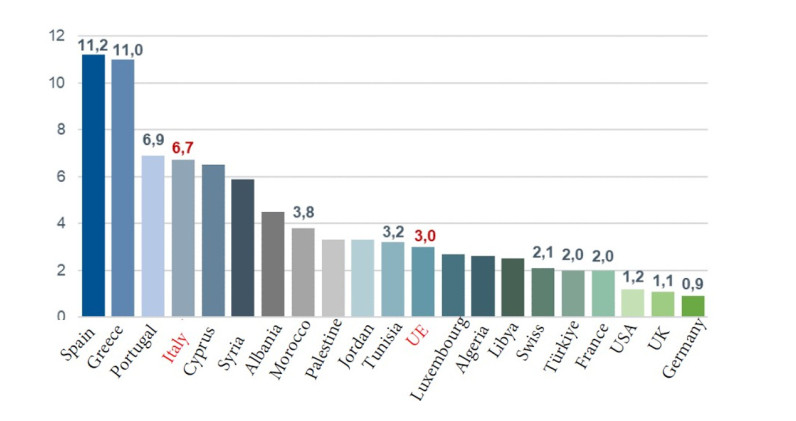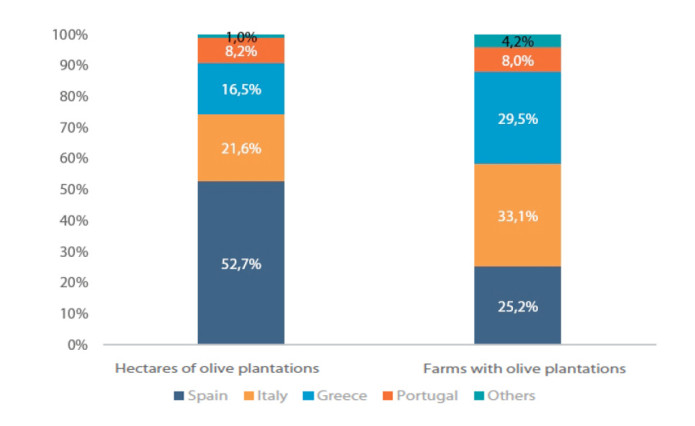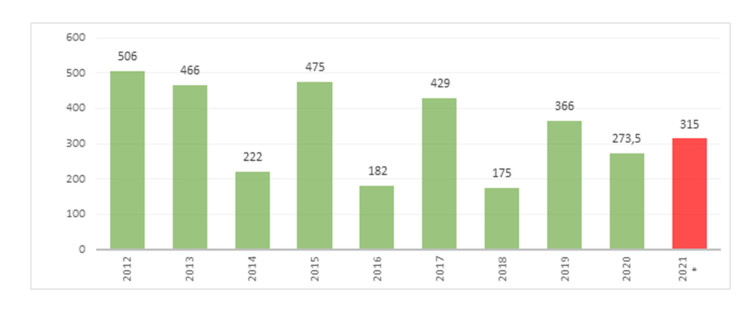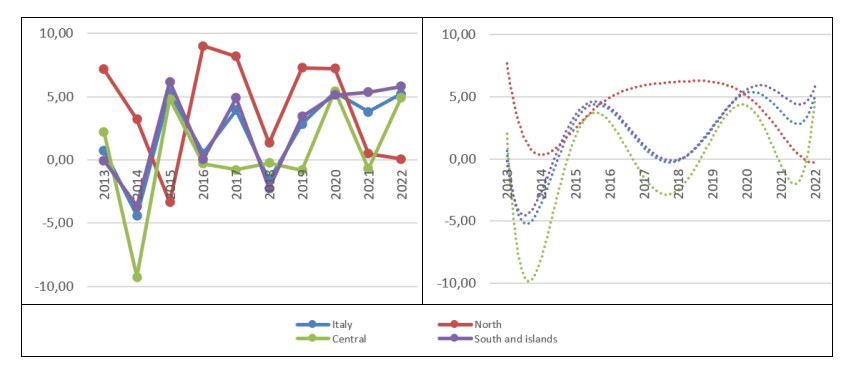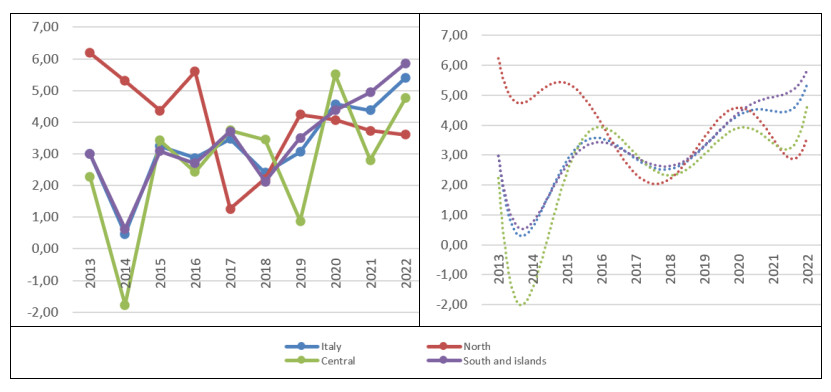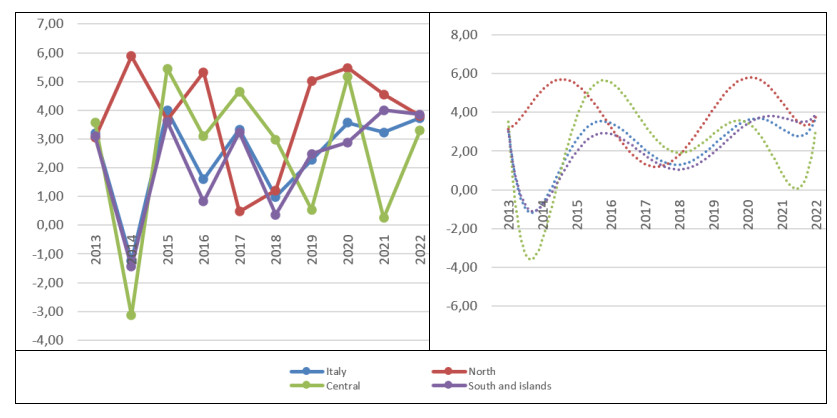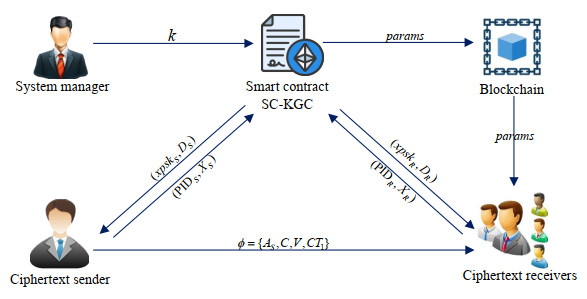1.
Introduction
Olive oil is a natural food extracted from olives characterized by many monounsaturated fatty acids (Aparicio and Harwood, 2013; Attorre et al., 2021).
With some unique industrial rectification processes (Boskou, 2006), it is possible to distinguish different types of products (Conte and Servili, 2022): extra virgin (also called "E.V.O."), virgin, lampante, refined, etc., to which the term "organic" can be added if it is derived from 95 percent, by weight, organically grown olives.
Different chemical and physical parameters, which also try to limit the risk of adulteration, generate these different types. These parameters, however, are not unique in the world, even considering different food traditions.
There are seven typical production phases: harvesting, storage, defoliation and washing, milling, kneading, extraction, and storage and bottling. From the artisanal production of oil mills, a technological revolution of production processes has occurred in recent decades, consistent with a cultural evolution that has enriched olive oil with sensory properties and additional health functions. Different products result from different product characteristics of the olives or even from particular blending processes. Highly heterogeneous olive oils, in terms of organoleptic and nutritional qualities, are destined for different market segments. Technological innovations have also resulted in a "digital fingerprint" that aids in combating fraud. Collaboration between stakeholders has also created an "Oleum network" for disseminating evolving knowledge (Contò, 2005; Attorre et al., 2021; Di Gioia, 2022). In addition to the modern automated mill, there is the evolution of packaging aimed at preserving the product's product and organoleptic characteristics and respecting the environment (Caricato, 2017). Technological evolution is also entrusted with tackling typical environmental sustainability issues, considering that olive cultivation can lead to water stress, soil erosion and salinization. The use of pesticides and fertilizers, which are harmful to the soil and groundwater, should be limited as much as possible. Plants should also avoid the emission of greenhouse gases. Production residues such as pomace, vegetation water, and prunings should be adequately disposed of, differentiating them from other waste (De Gennaro et al., 2012; Scarpato et al., 2013; Boesen et al., 2019).
Olive oil is considered particularly valuable for human nutrition due to the presence of antioxidant substances, which are more numerous in extra virgin olive oil (Boskou, 2015). Anti-inflammatory, vasodilator, antibacterial, and anti-oxidative stress properties caused by free radicals and cholesterol characterize this natural product. It is, therefore, an adequate food for preventing cardiovascular disease (Preedy and Watson, 2020).
The cultivation of olive trees and the consequent production of olive oil are mainly located in the Mediterranean area, whose climatic characteristics are particularly suitable (Alfei et al., 2013). Therefore, the primary producers are the European Union (E.U.) and some African and Mediterranean countries. This justifies the regulatory interventions of the European Union Commission, which adopted Regulation (E.C.) No. 1019/20021 to dictate rules on the marketing of olive oils2, later amended by Regulation (E.U.) 2022/21043. There have been several provisions in Italy, including the so-called "Save Oil Law"4, which generated a veto from the E.U., opening yet another dispute (Lanzara, 2017) and by labelling rules already established by Legislative Decree No. 109/925. Legislative Decree No. 125 of May 22, 2011 is in force6, as well as other provisions of the competent ministries.
1 Published in the Official Journal of the European Communities of 14.6.2002.
2 Sales to the final consumer must take place in containers with a maximum nominal capacity of up to 5 litres, with a closure system that loses its integrity after the first use. Larger quantities are foreseen for use in mass catering.
3 Published in the Official Journal of the European Union No. L 284 of 4.11.2022.
4 Law 14/1/2013 No. 9: 'Rules on the quality and transparency of the virgin olive oil sector', in Official Gazette, General Series No. 26 of 31.1.2013.
5 Implementing Directives 89/395/EEC and 89/396/EEC on the labelling, presentation and advertising of foodstuffs. The decree was published in the Official Gazette, General Series, No. 39 of 17-02-1992 - Ordinary Supplement No. 31.
6 "Implementation of Directives 2008/97/EC and 2009/32/EC on the quality of foodstuffs of plant origin" in Official Gazette No. 125, 31.5.2011.
The primary market of olive oil is focused mainly on the producing countries, considering the established food habits, including the "Mediterranean diet" (Moro, 2014).
Besides the typical destination of olive oil as an essential complementary food, its production can also generate, similar to wine (Gómez-Carmona et al., 2023; Soós and Dávid, 2015; Scherhag et al., 2023), oleo tourism, oil tourism that combines tastings of local olive productions, visits to production sites, outdoor activities among olive groves with olive harvesting experiences, oil-based cosmetic treatments, stays in thematic hotels, etc. (Garibaldi, 2024, Pulido-Fernández et al., 2022; Hernández-Mogollón et al., 2021; Pato, 2024; Vena-Oya and Parrilla-González, 2023).
The production of the olive oil chain and its direct and indirect market are thus a fundamental element of some European nations, including Italy. Therefore, it is appropriate to develop studies focusing on the economic aspects of oil and oil companies and verify the relationship between environmental turbulence due to pandemics and wars and their performance as measured by financial statements.
In other words, it is intended to verify whether political, health, meteorological, and other factors can somehow affect the profitability of companies, or whether they can guarantee stable profits, considering the importance of this food. This is our fundamental research question.
To this end, this study focused on the evolution from 2013 to 2022 of the main profitability indexes of 2250 Italian companies that rank among the world's most important ones. Considering, then, the characteristics of the nation and the significant cultural and economic-social differences between macro-regions (Felice, 2007; Menzani, 2007; Viesti, 2021), the overall figure for the entire country is broken down into three zones, considering that not all of them have similar climatic and morphological situations that profoundly affect the production of the raw material.
The disaggregated figure is subjected to numerous statistical elaborations to make a helpful comparison to focus on the geographical location of the best profitability.
In summary, this study aims to verify whether the profitability of Italian olive oil production companies is consistently positive and high, or whether it has decreased due to restrictions aimed at containing the COVID-19 virus infection. The aim is also to assess whether the different characteristics of the Italian macro-regions affect profitability. The hypotheses to be examined are therefore these.
After a preliminary and necessary review of the international literature, the paper summarises the main production characteristics of the international and national olive oil market. The study describes the research methodology used and the results of the analysis. These results reveal an instability in the outcomes, with constant fluctuations and an absence of statistically significant differences between the three macro-regions. The main limitation of this study is its purely quantitative nature. The results are helpful to Italian and foreign entrepreneurs who can relate their situation to the average situation in context. Public authorities can also use these elaborations to determine supportive policies. The study should consider other profitability ratios, capital, and financial structure ratios in the future.
2.
Literature review
The best international bibliography on the economic performance of olive oil enterprises focuses mainly on strategic and managerial aspects that tend to improve it. It is evident in the contributions of several authors that there is a marked sensitivity to the need for environmental protection; therefore, this theme frequently appears alongside the theme of sustainability.
This is already evident in a 2013 paper from research by Accorsi et al., who analyzed the life cycle of an extra virgin olive oil supply chain and analyzed supply, processing, packaging, and distribution activities, investigating the effects of adopting alternative packaging solutions. In this case, ecological choices, which many consumers are currently sensitive to, improve economic performance. The relationships between sustainability and nonpolluting olive oil packaging also inspired the study by Boesen et al. (2019), which showed that consumers have limited knowledge of sustainability-related eco-labels. Closing these gaps requires actions by producers, retailers, and policymakers so that consumers can make choices based on better information.
Pellegrini et al. (2017) subsequently followed a very similar approach. They proposed a model that compared olive oil cultivation systems' production costs and economic margins in "high density" and "very high density" systems. The study aimed to determine the efficiency parameters of olive production, establish minimum levels of economy, and determine which systems were the best performing. This article, therefore, can be placed somewhere between typical economic analyses based on accounting processing and profiles related to production management. Here again, however, the assessment of economic performance transits through the focus of technical processes, considering only in part the information power of accounting-derived systems.
The technical processes to be improved are also the subject of further reflection by Stillitano et al. (2017), which correlates with the previous study. Premising that intensive olive-growing models have received much attention for their positive effects on profitability, they propose new cropping systems characterized by higher yields and advanced levels of mechanization. Lower technology costs are expected to encourage process innovation, resulting in significant improvements in olive oil quantity and quality, with increased profitability for all players in the supply chain.
The absolute belief that environmental performance in the olive oil sector could assume strategic importance, not only for sustainability but also as a distinctive element for the future competitiveness of the Italian olive sector, inspired the analysis of Scarpato et al. (2013). Sustainable technological innovations, which would also improve economic performance, have already seemed possible in the past decade, considering that their survey recorded an increased focus on quality and the environment by producers despite a modest and often ineffective use of public support.
Scholars have paid much attention to production processes related to sustainability. However, improvement in economic performance could also come from a more evolved marketing approach. Several authors are convinced of this, including first and foremost Gorgitano and Sodano (2019), who found that consumers prefer extra virgin olive oils with an aromatic profile, unfiltered, obtained from Italian olives, certified as organic, with designations of origin, and sold in small bottles. Consequently, firms should recover and improve their economic performance with production and communication choices that can effectively intercept the preferences of different market segments: adequate differentiation policies are, therefore, imperative.
Differentiation alone, however, would not be enough, according to Castilla-Polo et al. (2018), who believe instead that a good reputation of the productive enterprise, especially if it is cooperative, is also necessary. The reputation would reflect four variables: innovation, certification systems, social responsibility, and rewards. This area should utilize reputation as a critical performance indicator alongside differentiation.
Improving economic performance through more judicious marketing policies cannot avoid new technologies, especially new distribution channels that can use the Web (Borsellino et al., 2018). E-commerce is not adequately used, as demonstrated by the websites of olive oil-producing and distributing companies; Web pages are too often mere communication and promotion tools, forgoing the enormous potential of the new economy.
It is safe to assume that in several nations, including Italy, the excessive fragmentation of production into many small-scale factories can be a significant obstacle to production and marketing innovation to improve economic performance.
It is, therefore, crucial to remove cultural barriers to greater collaboration among firms (Gurrieri and Spallini, 2016) by favoring any model that develops networks to benefit economies of scale. This requires improving the quality of relationships at any stage of the supply chain (Mesic et al., 2018) by focusing on and resolving possible obstacles in any of the components of the interpersonal relationship: trust, commitment, economic satisfaction, noncoercive and coercive power, reputation, and conflict.
Family businesses also need to open up to a more excellent cooperative spirit with the outside world, considering that a higher level of family involvement in businesses seems to imply more significant difficulties with collaborative arrangements (Sanchez-Famoso et al., 2019).
These studies offer valuable insights into the appropriate ways for industries to modify their strategies, focusing on the main levers to act: cultivation techniques, product differentiation, digital marketing, collaboration among operators, and environmental sustainability.
However, specialized studies on economic performance based on financial statements are lacking. We would like to make up for this in this paper by testing the following hypotheses:
H1: The profitability of olive oil companies is consistently positive and high.
H2: It has been affected by the pandemic due to restrictions aimed at containing the contagion.
H3: The different morphological and socioeconomic characteristics of Italian macro-regions affect the profitability of enterprises.
Premising some significant industry statistics, we proceed with analyses of the annual financial statements from 2013 to 2022 of 3184 companies from Italy and its macro-regions (North, Center, South, and Islands). Average ratios were calculated yearly, specifying the number of observations and the main descriptive statistics. Broken lines and interpolating curves obtained from 6th-degree polynomial equations maximizing R2 graphically represent the trend. One-way ANOVA (analysis of variance) and Tukey-Kramer methods statistically compare macro-regions.
3.
The sector
3.1. In the world and Europe
In recent years, olive cultivation has spread rapidly outside of the Mediterranean, including countries such as the United States, Japan, China, Argentina, Australia, Chile, South Africa, and Peru.
Surprisingly, the 2021/2022 production year exceeded pessimistic forecasts with a production of about 3.4 million tonnes, registering a 13 percent increase (Sarnari, 2022). Most major producing countries have increased production. As shown in Figure 1, world production has always had a discontinuous but overall positive trend. Production after 1995 declined sharply, with negative signs in 2012 and 2014.
7 The Faostat website: https://www.fao.org/statistics/en
Europe, America, Asia, Africa, and Oceania are the major olive oil-producing areas worldwide.
As shown in Figure 1, Europe has the most significant percentage of production, which defines the production trend worldwide.
The European Union produces an average of 3 kg of olive oil per citizen annually, meeting consumer demand within the region. Spain and Greece are the top consumers of olive oil in Europe (Figure 2).
The market leaders, in terms of consumption, also include Portugal and Italy, followed by France and Germany, the United States, and the United Kingdom, showing low values, mainly due to eating habits that more rarely contemplate using olive oil.
Regarding land area and number of farms with olive groves, the central producing countries are Spain, Italy, Greece, and Portugal. Spanish farms have the largest average area of olive groves, with about 5.8 hectares per farm in 2013, followed by Portugal with 2.8 hectares (Figure 3).
3.2. In Italy
Italy has always been one of the world's leading olive oil producers, averaging more than 300,000 tonnes annually (Figure 4).
Two-thirds of Italian production is extra virgin olive oil, which the European Union recognizes, with thirty-nine protected designations of origins (P.D.O.) and one protected geographical indication (P.G.I.) (Di Schino et al., 2016).
Italy ranks second in the world and first in imports and consumption.
The South concentrates most of the production, with 51 percent coming from the Puglia region, 13 percent from the Calabria region, 10 percent from Sicily, and 4 percent from Campania (Adamo et al., 2020).
However, with about 827 thousand active agricultural enterprises and an average area of 1.2 hectares, the Italian olive oil sector is uneven and highly fragmented, showing a low capacity for aggregation.
Climatic problems (frost and drought negatively affect the vegetation of the olive grove and its fruit) are perhaps the cause. The exponential and generalized increase in input prices may be a further reason. Over the past decade, an exorbitant instability in production results can be seen. After the record of 2012 with 506 thousand tonnes, there followed vintages with sharp declines in 2014, 2016, and 2018, in which production fell to 222,182, and 175 thousand tonnes, respectively, with signs of recovery in 2019 (Adamo et al., 2020).
Even though production in the past ten years has declined by 15 percent, it seems destined for further contraction.
4.
Materials and methods
The annual financial statements, especially when subjected to a twofold analysis by ratios and flows, are the tools for obtaining all of the information needed to analyze the economic performance of companies active in the olive oil sector.
Verifying the assumptions underlying this study requires, in particular, an index analysis focusing on income.
The analysis of financial statements presupposes its reclassification into meaningful groupings and the subsequent calculation of ratios deemed expressive of certain business situations (Mella and Navaroni, 2016).
Information from the archives of Moody's Analytics, which inherited the functions previously performed by Bureau van Dijk, is the basis for this study.
The survey covers the decade 2013–2022 and considers the 10-year trend of the following ratios:
- Return on equity (R.O.E.);
- Return on investment (R.O.I.);
- Return on sales (R.O.S.).
The data were subjected to some descriptive statistical elaborations, valid for a better understanding of the phenomenon: mean, median, standard deviation, sample variance, skewness, minimum, maximum, and count (number of observations).
Instead, the ANOVA test, or "one-way" analysis of variance, was used to compare the means of three or more groups with a single analysis. It was developed by the best scientific scholarship (Gu, 2013; Solari et al., 2009; Ross & Willson, 2017; Liao & Li, 2018; Fink, 1995) and has already demonstrated its suitability in applications of this kind (Migliaccio and Pavone, 2022; De Blasio et al., 2022).
ANOVA is a mathematical method that breaks down the total variance into its components by identifying the underlying causes. It is based on two hypotheses:
- The null hypothesis (H0) that the data from all geographic areas considered have very similar means, such that there are no significant differences between the group means;
- The alternative hypothesis, on the other hand, is that at least one of the observed geographic areas exhibits a significant difference.
Using the ANOVA test, one can then define whether statistically significant differences exist among the geographic areas but not identify the mean that differs from the others.
To overcome this limitation, it is necessary to study the post-ANOVA test, the so-called Tuckey-Kramer test (Tukey, 1949, 1953, and 1993; Kramer, 1956).
Income analysis is crucial to understanding the ability of firms in the industry to remunerate the equity capital used for the entire output satisfactorily.
The purely quantitative nature of the study is a limitation because it does not allow the phenomenon to be related to qualitative aspects that also affect the profitability of companies and, more generally, the sector's valuations. The choice, however, has made it possible to focus on relevant aspects, direct future research efforts, and hope for more holistic analyses in the future integrating qualitative insights and contextual considerations.
The statistical tools used, which are rigorous in method and outcome, allow for immediate, unobjectionable considerations, even within the limitations of the sample used. Moreover, they are particularly suited to complex elaborations on balance sheet ratios and their possible spatial and temporal comparisons, which considerably amplify their informative value.
5.
Results
5.1. The sample
Olive oil production falls under the more general macroeconomic sector of "Manufacturing" in the category of "Food Industries" and the sub-category of the "Manufacture of vegetable and animal oils and fats". The sub-category is also quite broad because it includes producing olive oil, seeds or fruits, crude or refined animal oils and fats, and margarine.
The Nace Rev. 2 and Ateco 2007 codes (updated 2022) identify the macro sector with the letter C, the category with the number 10, and the sub-category with 10.4. The Nace Rev. 2 codes only distinguish two groups: 10.41 "Manufacture of oils and fats" and 10.42 "Manufacture of margarine and similar edible fats". Ateco classifications provide greater detail, allowing for the distinction between the production of olive oil from olives predominantly not of own production (10.41.10), refined or crude oil from oil seeds or oil fruits predominantly not of own production (10.41.20), crude or refined animal oils and fats (10.41.30), and the production of margarine and similar edible fats (10.42.00).
This study only refers to the olive oil production of a sample of 3184 Italian companies operating in 2013–2022. At the time of data extraction from Moody's Analytics archives in the spring of 2024, not all of the companies were active. Table 1 describes their legal status.
Table 1 reveals a clear predominance of activities in Southern Italy compared to the Center and the North. The South has the most significant number of active enterprises, with 2226 still in operation: the climatic and territorial conditions are particularly favourable for olive cultivation.
The number of active companies in Central Italy is significantly lower, with 455 companies, while the North has only 206 active companies.
Active enterprises with insolvency proceedings are rare: only two cases were recorded in total, one in the North and one in the South. Even less frequent are active companies in insolvency, with only one case in the South.
However, the South also has the highest number of terminated enterprises, 49; the Center, 22; and the North, 10. Closures due to bankruptcy are also more present in the South and the Center, although the number is small: only 2 cases. Closures through mergers are the most frequent, with 15 cases: 9 in the South, 2 in the Center, and 4 in the North.
The number of enterprises in liquidation is significant, with 86 cases: 69 in the South, 8 in the Center, and 9 in the North.
Bankrupt enterprises are more numerous in the South (11), followed by the North (10), and then the Center (7).
The prevailing legal form is typical of small enterprises, as shown in Table 2.
Small enterprises characterize Italy's olive oil production sector in 2022 as most have an annual turnover of less than 2 million E.U.R. (Table 3)8.
8 The number of observations was specified because the information was not always available.
Investments are also relatively modest, as detailed in Table 4.
In 2022, the sector will employ around 11,000 people in many small and medium-sized companies (Table 5).
5.2. Return on equity (R.O.E.)
The return on equity (R.O.E.) ratio expresses, in percentage terms, the ability of management to remunerate equity. First, Table 6 presents the descriptive statistics.
The R.O.E. of the three geographic areas fluctuates, with rising and falling variations over the decade considered. In particular, the North shows a profitable sector, except for 2015, when the index has a negative sign (−3.37). Even in the Center, R.O.E. alternates between positive and negative values, sharply declining in 2014 (−9.28). The situation is also similar in the South, where negative ones follow positive values.
To graphically represent the trend of the average index, we identify the best interpolating equation that maximizes R2 (see Table 7).
The graphs in Figure 5 reflect this. They compare the broken line and the interpolating curve.
Thus, a sector with solid fluctuations emerges. The North curve is higher, despite the sharp decline in 2015, when the Center and the South and Islands recorded growth, just as the North regresses.
Very often, the curves of the South, the Islands, and Italy tend to overlap because the Southern areas have average trends in a context where the positive ones of the North balance the negative peaks of the Center.
The analysis of variance highlights the statistically significant differences (see Table 8).
Comparing the F value and the F crit value shows that the H0 hypothesis is accepted, as the F value is less than the critical F value: there are no statistically significant differences to be confirmed by the subsequent post-Anova test (see Table 9).
The pairwise comparison, therefore, shows no statistically significant differences between the areas.
5.3. Return on investment (R.O.I.)
R.O.I. measures, in percentages, the profitability and economic efficiency of typical management. Table 10 shows the main descriptive statistics over the period considered.
To graphically represent the index trend, the best interpolating equation that maximizes R2 is found (see Table 11).
The R2 values show a modest representativeness of the macro-region curves, which are helpful (see Figure 6).
Over the analyzed period, R.O.I. has a trend characterized by strong fluctuations in all geographical areas.
Conversely, the North shows higher values, especially in 2011 (8.17%) and 2016 (6.086%).
The olive oil sector comprises average profitable farms, except for a few years, for some areas where the R.O.I. value was close to zero (2011, 2014, 2016, 2018, and 2019).
Table 12 shows the analysis of variance with the R.O.I. ANOVA test.
F is greater than the critical value: the hypothesis H0 is rejected. There are no statistically significant differences between the zones, as confirmed by the Tukey-Kramer test (see Table 13).
5.4. Return on sales (R.O.S.)
R.O.S. analyzes sales profitability and results from the percentage ratio of operating profit to invested capital. Table 14 illustrates the descriptive statistics.
To graphically represent the index trend, the best interpolating equation that maximizes R2 is found (see Table 15).
R2 values show a modest representativeness of the macro-region curves, however useful (see Figure 7).
Again, the sector shows almost always positive R.O.S. values except for 2014, when both the South and the Center showed negative declines, −1.44 and −3.14, respectively.
The ANOVA test (see Table 16) accepts the null hypothesis, as the F value is lower than the critical F value.
The Tuckey-Kramer test (see Table 17) is also necessary for R.O.S. It confirms significant differences between the areas.
6.
Discussion and conclusions
This study investigated and measured the economic performance of Italian olive oil companies, considering the importance of this sector of the national economy and, more generally, for proper human nutrition, mainly when aimed at the prevention of certain serious diseases.
The research focused on companies that satisfy a primary need for nutrition, including olive oil. In countries where it is produced for cultural reasons and atavistic gastronomic traditions, people unfortunately consume it prevalently.
This analysis enriches knowledge of the production reality of a country that is a leader in olive oil production and consumption, albeit considering the economic and social differences that characterize the different macro-regions that were compared (Felice, 2007; Menzani, 2007; Viesti, 2021). It, finally, implements the existing literature with quantitative financial analyses based on annual financial statements, unfortunately neglected by the best doctrine that has instead focused on the very current issue of sustainability (Accorsi et al., 2013; Scarpato et al., 2013) and on marketing issues that have mainly focused on alternative packaging hypotheses (De Gennaro et al., 2012; Boesen et al., 2019) that also affect the broader concept of corporate reputation (Castilla-Polo et al., 2018). This applies to family businesses, especially in Spain (Sanchez-Famoso et al., 2019).
The sales marketing perspective always influences research focused on the Italian context aimed at favoring product differentiation (Gorgitano and Sodano, 2019) and more widespread use of the Web for e-commerce (Borsellino et al., 2018). This is in addition to reflections related to productivity developments aimed at the spread of intensive cultivation (Stillitano et al., 2017; Pellegrini et al., 2017) in the common desire for greater collaboration among enterprises (Gurrieri and Spallini, 2016). Overall, performance has been investigated in strategic approaches and concerning production and marketing functions, eschewing annual reports that often appear as a mere formal fulfillment, not affecting decision-making processes.
Instead, this study re-evaluated the relevance of traditional business accounting and periodic summary statements. These annual results can provide valuable insights into the economic goals achieved in their medium- to long-term trends.
It is precisely because of the availability of a large sample of financial statements over a long period that it has been possible to make thoughtful assessments concerning the three hypotheses placed at the origin of the previous analyses.
Having investigated the trend of the three economic ratios makes it possible to deny the validity of the first hypothesis, H1: the profitability of olive oil companies is not consistently positive and high. On the contrary, there has been an extraordinarily irregular and fluctuating trend, likely due to the different productivity of olive crops, which affects meteorological and bacteriological phenomena. It is, therefore, logical to intuit an apparent connection between the trend in raw material production and the economic performance of the agro-industry closely related to it. Although the use of olive oil is considered fundamental in the food traditions of some countries, and constant consumption would therefore be assumed, this does not register in the variable economic performance of the companies that offer it.
The spread of COVID-19 seemingly caused no impact, as no particular trends were recorded in the years characterized by the pandemic. Therefore, it is also necessary to deny the second hypothesis, H2: it is not true that economic performance was affected by the pandemic due to restrictions aimed at containing the contagion.
The third hypothesis is also denied, H3: it is not true that the different morphological and socioeconomic characteristics of the Italian macro-regions influence firms' profitability. Despite the first impression when looking at the graphs, the use of ANOVA and Tukey-Kramer tests excludes significant differences in the performance of the three Italian macro-regions. The visible differences tend to even out over the decade.
The implications of this study for theory and practice are numerous. Researchers call for further studies using accounting information systems beyond bureaucratic compliance or taxable income determination. They can and should prove to be the first source of information for any management choice. Similar analyses of a single project that has already offered numerous highly appreciated results to the international scientific landscape listed in Table 18 demonstrate their value.
The methodology can be easily applied to different sectors, facilitating spatial and temporal comparisons referring to the same nation or even to different nations but sharing similar productions.
A necessary condition is to have the availability of balance sheet data for at least a decade for a significant sample of firms. Therefore, scientific research and operational practice must be indebted to databases that make potentially beneficial information available.
Familiarity with accounting outcomes, however, must also merge with statistical skills that allow for more analytical study evaluations that foster objective and meaningful comparisons.
This article empowers individual practitioners to improve their operational practices. They can achieve this by comparing their firm's situation against the industry average and identifying potential gaps for improvement. Thus, benchmarking logic is fostered (Watson, 2000; Kharlamova et al., 2020; Bhattacharya et al., 2020).
Performance evaluation would, therefore, be in addition to any other typical management planning and control tool that should already be used at any company wishing to initiate innovative and effective management processes.
Trade associations can also use this study for available information, albeit aimed at applying facilitative tools for the agribusiness sector.
On the other hand, the relevant public authorities can also have a better knowledge of the sector to wisely direct benefits to support a production that has characterized many areas of productive countries for decades. This is also to spread sustainable logic that is urgently needed, considering the progressive erosion of land used for olive production and thus subjected to water stress, soil erosion, and pollution by pesticides and fertilizers. Waste gases from agro-industrial plants, waste disposal and processing waste also contribute to an unhealthy environment. Sustainable agricultural practices (organic and precision farming, efficient water management, cover crops) and waste recycling to produce energy, compost, and other things must necessarily and urgently be adopted with innovative technologies.
Studies by Pulido-Fernández et al. (2022), Hernández-Mogollón et al. (2021), Pato (2024), and Vena-Oya and Parrilla-González (2023) highlight the importance of developing oil tourism. This development can significantly benefit all production areas, especially with the well-established wine tourism (Gómez-Carmona et al., 2023; Soós and Dávid, 2015; Scherhag et al., 2023).
Future analyses of this kind should be developed by researchers using additional and more numerous profitability ratios. These ratios should then be juxtaposed with those typical of the capital and financial structure. Certainly to be considered in future profitability analyses are the R.O.S.: return on sales, which is calculated using the formula: operating income/revenues from sales x 100; the G.O.P.: gross operating margin, EBITDA (earnings before interest, taxes, depreciation, and amortization), which measures the ability of capital to generate wealth before taxes, interest, depreciation, and amortization; and the EBIT, which measures the ability of capital to generate wealth before taxes and interest. Particularly relevant for indebted companies is the financial expense coverage ratio.
To analyze this economic sector, consider these capital ratios: the degree of dependence on third-party financing, which reveals the relationship between equity capital and other financial sources. In industrial companies, measuring the degree of asset immobilization is used to assess asset elasticity.
More generally, measuring source-asset correlations and indicators of asset turnover speed and, thus, average inventories will be appropriate.
Furthermore, the synthetic values obtained should be compared with those of other related sectors to highlight similarities or divergences and assess their causes.
Educators and trainers should leverage studies of this kind in their management education and training processes.
The outlined benefits deriving from this study for science and operational practice must not make us forget that the proposed outcomes derive from a purely quantitative study based on a limited number of balance sheets, albeit numerous. Its validity depends on the veracity of the official balance sheets. Unfortunately, especially in Italy, accounting frauds mainly aimed at tax evasion are often observed (Lupi, 2020; Boria, 2023; Scarfì, 2024), which justifies perplexity concerning the quality of the raw data processed. This, however, should not limit the informative value of the trends drawn. Analyses of this kind, therefore, cannot have the presumption of being exact, even considering that there are always estimated values (necessarily) in the financial statements.
Author contributions
This article is the result of collaborative work. However, it is possible to attribute the different paragraphs to the authors in relation to the prevailing tasks that were carried out.
Guido Migliaccio was responsible for the design and scientific approach of the work, outlining its theoretical aspects and theoretical analysis of the results. The "Introduction", "Literature review", and "Discussion and Conclusions" paragraphs can, therefore, be attributed to him.
Antonella De Blasio, on the other hand, analyzed the sector, selecting, and processing financial statements data, and presenting initial comments on the results of the research. The following paragraphs can, therefore, be attributed to her: "The sector" and "Results".
The paragraph "Materials and methods" is common to both authors.
Use of AI tools declaration
The authors declare they have not used Artificial Intelligence (AI) tools in creating this article.
Conflict of interest
All authors declare no conflicts of interest in this paper.
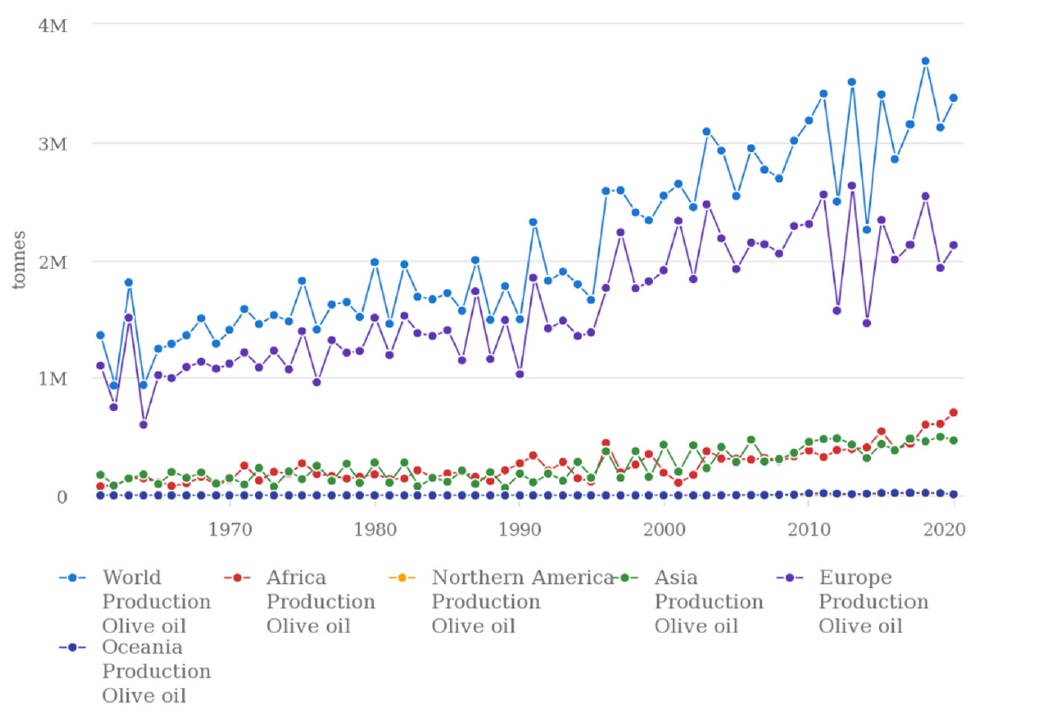









 DownLoad:
DownLoad:
